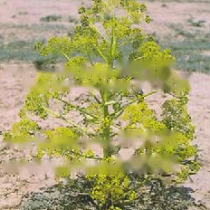
Chinese name: Xinjiang Awei
Latin name: Ferula sinkiangensis KM Shen
Family: Apiaceae
Genus: Apiaceae The genus Ferula
Distribution area: Xinjiang (Yining)
1. Morphological characteristics of Asafoetida in Xinjiang
The whole plant of Asafoetida in Xinjiang grows upright, with a height of about 1 meter to 2 meters, there is a smell of onion and garlic. The root is conical and stout, with withered sheath fibers at the top of the root. The stem is single, sparse and stout, pubescent, with branches upward at the base, alternate branches at the base, whorled at the upper branches, usually dark red. The basal leaves have short stalks, the leaves are triangular-ovate, three pinnatisects, the terminal lobes are broadly rounded and lobed, the top is serrated, the base is gray-green sparsely hairy, the back is densely pubescent, cauline The leaves become smaller and wither when mature. The cymose is born on the top of the stem and branch is pubescent, and the petals are yellow-green oval. The flowering period is April-May, and the fruiting period is May-June.
2. Habits of Xinjiang Asafoetida
Xinjiang Asafoetida often grows on the river bank terraces at an altitude of about 750-1000 meters in Xinjiang, and can adapt to the full sun growth environment. Dry climatic conditions, drought-resistant, not easy to lose water in dry season, not cold-resistant, slow growth or stop growth at low temperature, stricter soil requirements, suitable for growth in dry and loose lime-calcium soil, and the humus-containing layer is thin, It is resistant to barrenness, not suitable for growth in clay, not resistant to water and humidity, and plants are prone to root rot in stagnant water environments. Intolerant of shade.
3. The role of Xinjiang Asafoetida
Xinjiang Asafoetida is a rare wild medicinal material. In recent years, relevant departments in Xinjiang have carried out zoning protection, and there is a growing trend. The plant germinates every spring and grows into a large piece in summer. According to the data, the plant usually blooms in about 3 years. The plant is bitter in taste and warm in nature. It is an adjuvant treatment for diseases such as lumps, meat stagnation, blood stasis, etc. It is rich in various amino acids, proteins, glucans, etc. necessary for the human body. It is a rare dual-purpose bacteria in the world.
Guess you like it
Mosaic hosta | Tiger palm grass | Oil Vegetables | Geshanxiang | Snakeroot Grass | Oleum Grass |
Oxtail Grass | 10,000 hemp| Spearmint|
Big flower pot grass| >
![[Dog Training 5] The training method of pet dog dining etiquette](/static/img/12192/12192_1.jpg)




